Hebrew: אקליפטוס המקור, Arabic: كافور كينيا
| Scientific name: | Eucalyptus camaldulensis Dehn. | |
| Common name: | River-Red-gum | |
| Hebrew name: | אקליפטוס המקור | |
| Arabic name: | كافور كينيا | |
| Plant Family: | Myrtaceae, הדסיים |
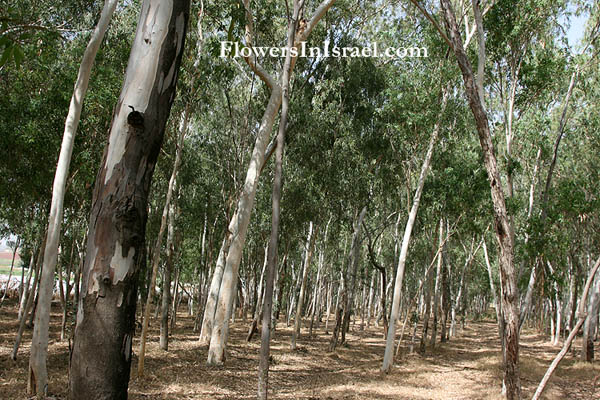
|
| Life form: | Tree | |
| Stems: | Up to 45m; single-stemmed, large-boled; bark, dramatically-striped patches, showing pale grey, charcoal and occasionally, pink bark patches | |
| Leaves: | Deciduous, alternate, lanceolate, acuminate | |
| Inflorescence: | Axillary, solitary, 7-11 flowered | |
| Flowers: | Hermaphrodite; Buds ovoid, not glaucous or pruinose; Calyx calyptrate; Calyptra hemispherical and rostrate (the calyptra is a covering tissue for stamens and carpels); flowers, green, cream | |
| Fruits / pods: | Very small capsules at the end of thin stalks, 5-8 mm, valves 4; seeds are cuboid or pyramidal, with smooth face 1–1.5 mm long; yellow to brownish yellow, with two seed coats | |
| Flowering Period: | April, May, June, July, August, September, October | |
| Habitat: | Humid habitats, Disturbed habitats | |
| Distribution: | Mediterranean Woodlands and Shrublands | |
| Chorotype: | Australian | |
| Summer shedding: | Perennating |
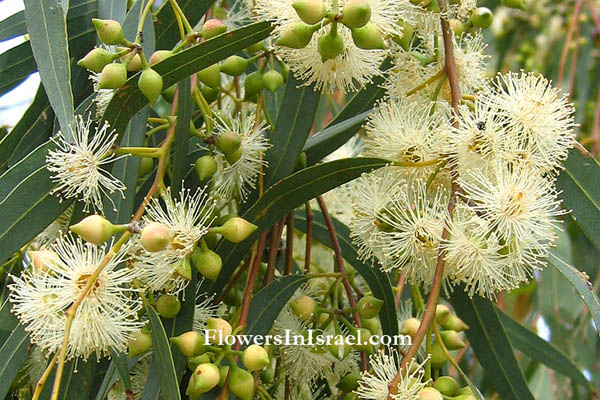
Derivation of the botanical name: Eucalyptus, Greek eu, good or well; kalyptos, covered, referring to the calyx which forms a lid over the flowers when in bud. camaldulensis, referring to L'Hortus Camaldulensis di Napoli, also known as the Camaldoli garden, a private botanical garden in Naples, Italy. The garden was established in 1816 by Francesco Ricciardi, Count Camaldoli, and features collections of Acacia, Agavaceae, Melaleuca, Eucalyptus camaldulensis (named in its honor). The Hebrew name: אקליפטוס, eucalyptus, transliteration from the scientific name.
There are more than 700 species of Eucalyptus, mostly native to Australia. At Ilanot, Israel is a varied arboretum with over 750 species of shrubs and trees, local and exotic, for forestry research and 170 different eucalyptus species (the largest eucalyptus concentration in Israel). One of the most widely planted eucalyptus in the world is the Eucalyptus camaldulensis, which originated in Australia. After pine, eucalyptus is the second-most popular tree for the paper industry and that there are some 130,000 square kilometers of eucalyptus forests worldwide. Eucalyptus camaldulensis is a tall, evergreen tree 24-40 m high. It has an attractive white trunk, whose bark exfoliates annually. The leaves are alternate, drooping, narrowly lanceolate, 8-22 cm long, 1-2 cm wide, often curved or sickle-shaped, tapering to long point, short-pointed at base, entire glabrous, dull pale green on both surfaces or occasionally grayish and have a characteristic smell. The flower is box-like with petals enclosing its opening. When the flower blooms, the petals fall off and the masses of protruding stamens provide the usually bland-looking tree with a colorful appearance. The first eucalyptus seeds were sent to Palestine in the 1880s from Australia. Eucalyptus camaldulensis in Israel were planted by foresters. Although eucalyptus can grow in swampy land, taking up massive quantities of water, it survives nevertheless under arid conditions. Eucalyptus camaldulensis is reported to tolerate alkali, drought, fire, light frost, heat, high pH, poor soil, salt, savanna, and waterlogging. It is rather intolerant of weeds. Its leaves are also valuable as they contain an oil used in alternative medicine. Leaves contain 0.1-0.4% essential oil, 77% of which is cineol. Leaves contain 5-11% tannin. Due to the toughness of its wood and thick trunk, eucalyptus became a major source of lumber. Forestation was undertaken to plant the uncultivated, barren land in order to obtain a legal holding on the purchased property. They were first imported at the end of the 19th century in order to dry swamps (a conviction later shown to be incorrect) covering large parts of the coastal plains and other areas. The largest plantings took place in the Hadera, Rosh Pina, and Petah Tikvah regions. In 1895 Baron Edmond de Rothschild, gave funds to Hadera to drain the swamps by building canals and planting large eucalyptus groves. The business of planting eucalyptus was so nasty that one of Rothschild's agents decided to compensate the foresters by giving them each a bottle of cognac per day as a perk. Morale quickly improved, and although workers began to arrive at work completely drunk, this did not seem to affect the productivity of their labor. The eucalyptus tree soon became Haderah's symbol. The tree was usually planted in the springtime in communities and settlements throughout Hayishuv. So common was the tree that Arabs began to call it shajarat al-Yahud, or “the Jews' tree.” In 1901, delegates to the Fifth Zionist Congress in Basel declared formation of the Jewish National Fund (KKL). This new communal endeavor was charged with purchasing agricultural land in Eretz Israel and leasing it to Jewish settlers. The British Mandate (1917-1948) sought to preserve existing forests through their Forest Ordinance (1926), which established 430 forest preserves throughout the country, totaling about 83,000 hectares. The Mandate authorities began afforestation in order to prevent land erosion, halt the shifting of sand dunes, provide wood and preserve the natural vegetation. Thousands of eucalyptuses were planted in the 50s along intercity highways to greenify the brown, desolate roadways and to provide employment for the country's newcomers. The forest law dating from the time of the British mandate is still valid, and a revised draft prepared by the Forest Department has not yet been officially approved.
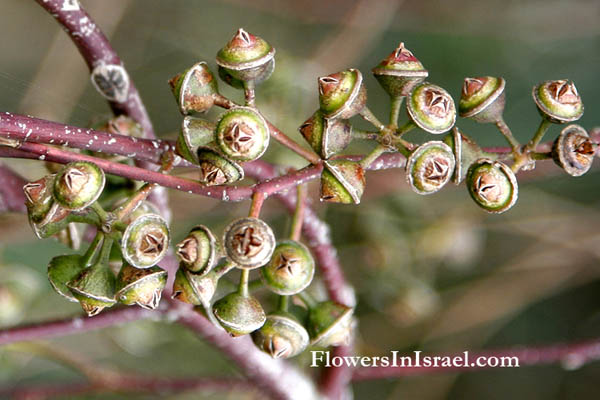
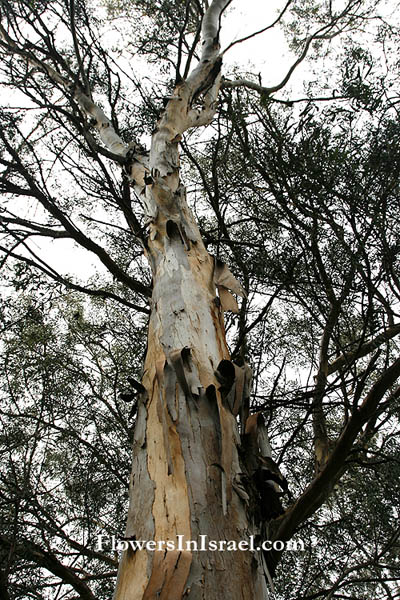
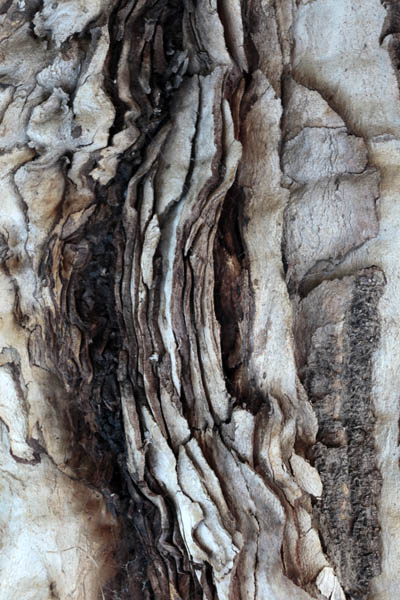
|
